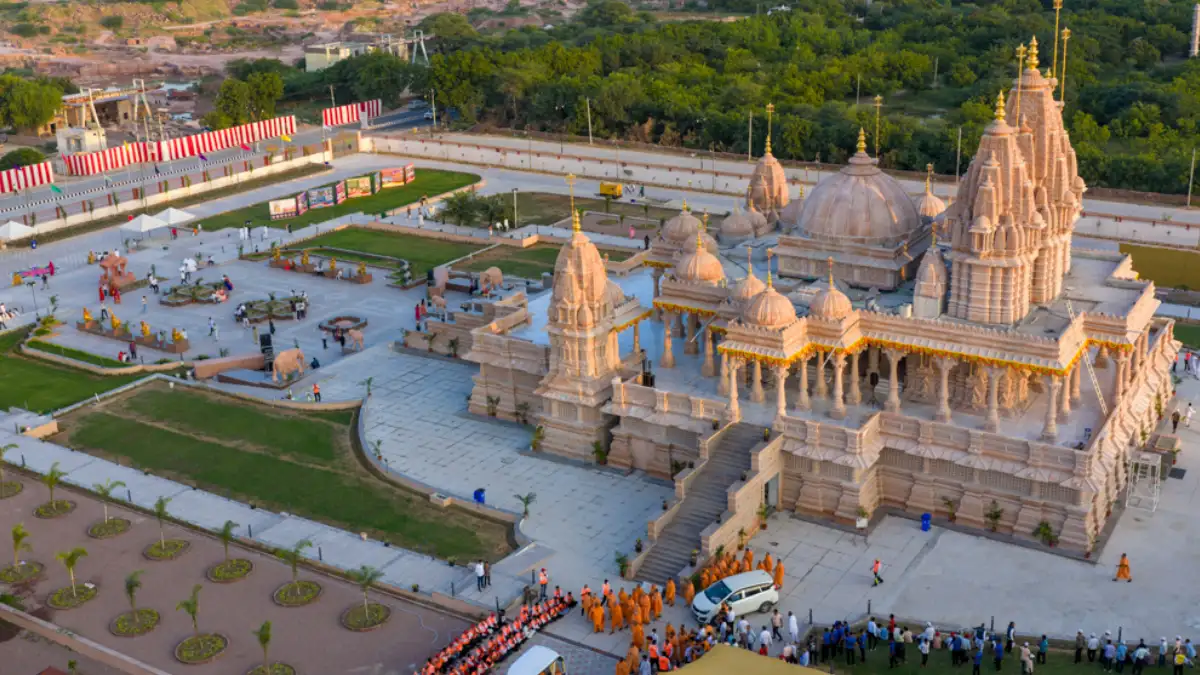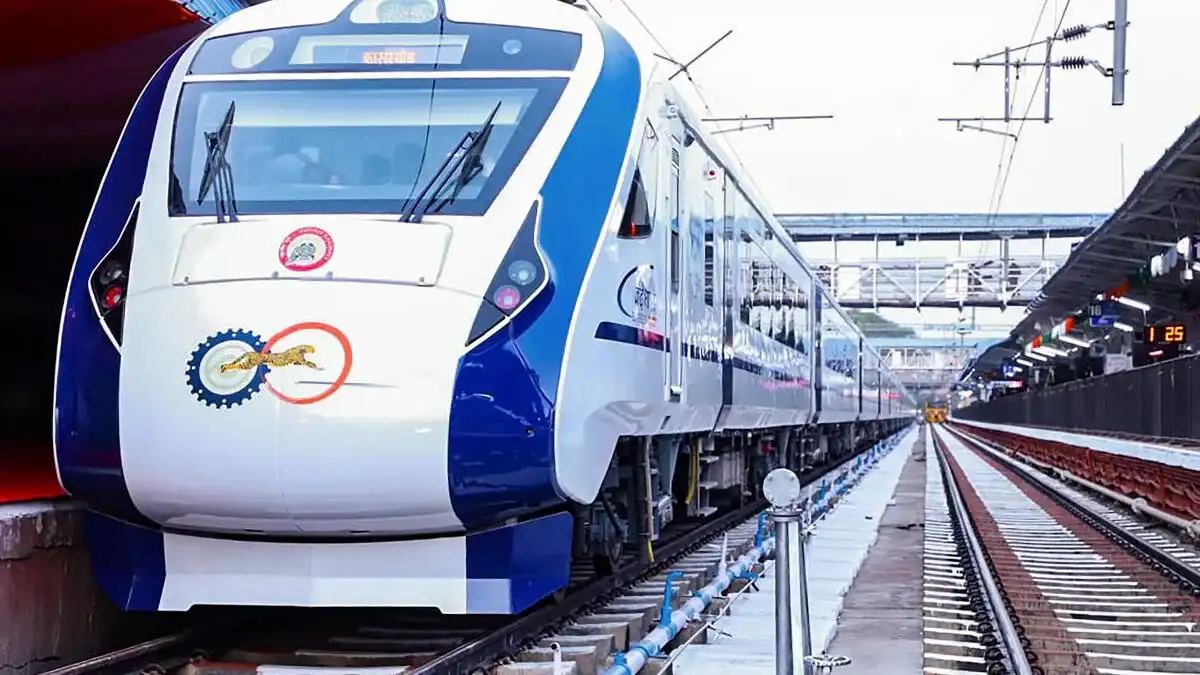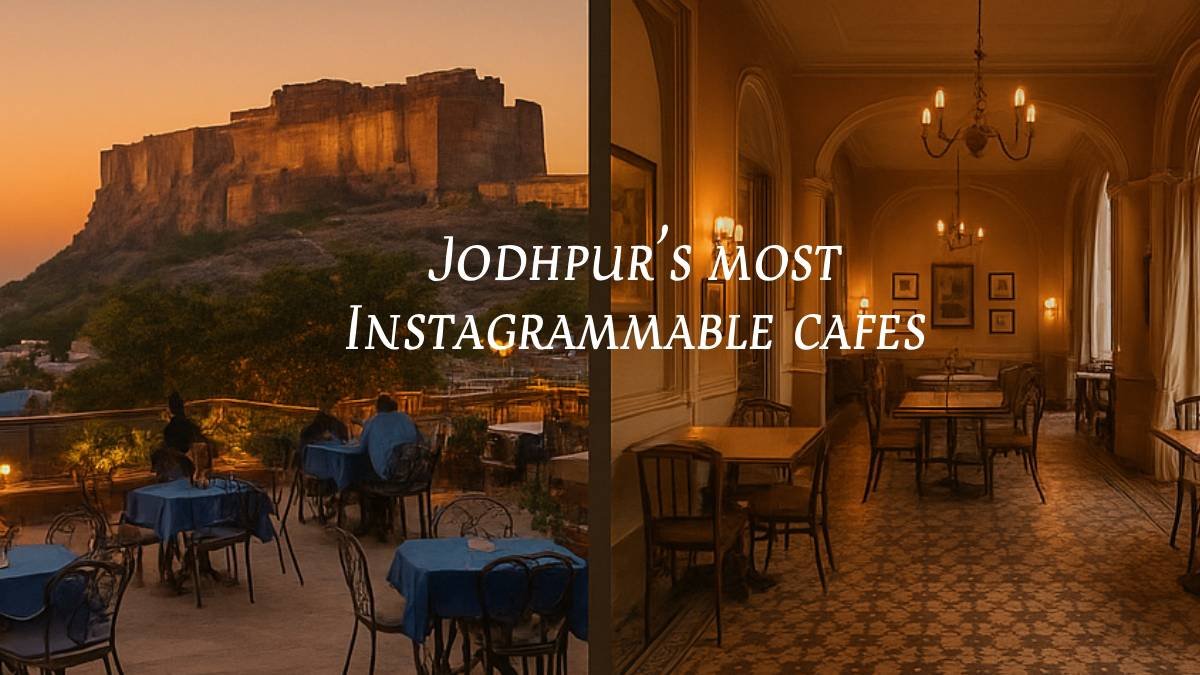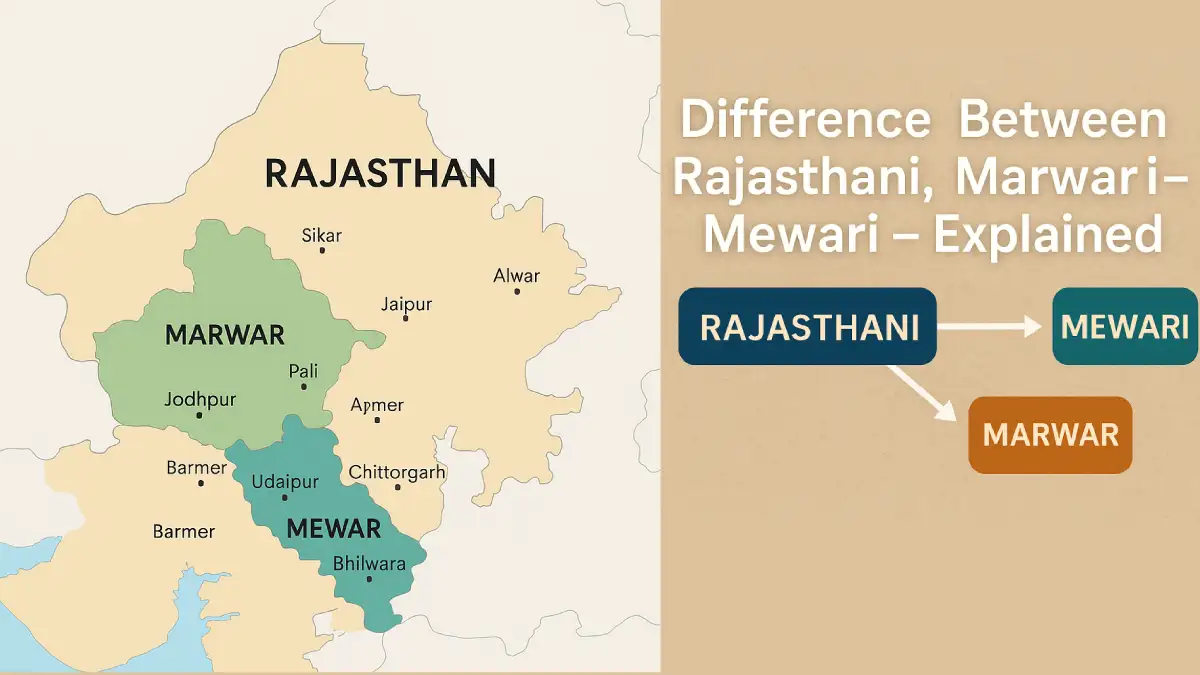Rajasthan, often called the Land of Kings, is a vibrant mosaic of language, culture, and history. While the world may see Rajasthan as a single cultural entity, its people speak many dialects and follow varied customs that are deeply rooted in regional identity. Terms like Rajasthani, Marwari, and Mewari are often confused or used interchangeably, but they hold distinct meanings.
This article will break down the differences between these terms, exploring their linguistic, cultural, and geographical contexts. By the end, you’ll have a clearer understanding of how Marwari and Mewari relate to the broader Rajasthani identity—and why these distinctions matter.
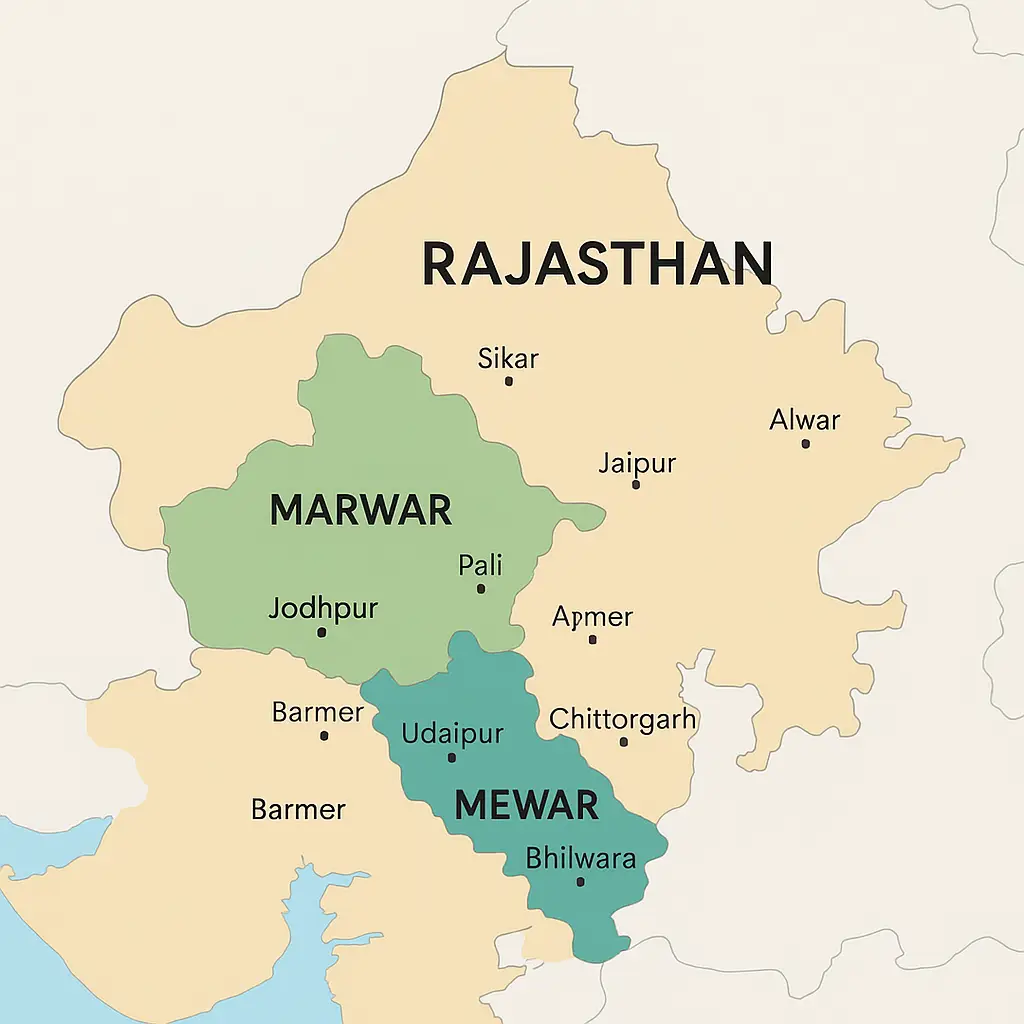
2. Understanding Rajasthani
2.1 What is Rajasthani?
The word “Rajasthani” broadly refers to everything related to Rajasthan—its people, languages, heritage, and customs. But linguistically, Rajasthani is not a single language. Instead, it is a language group that includes various dialects such as:
-
Marwari (spoken in Marwar region)
-
Mewari (spoken in Mewar region)
-
Shekhawati
-
Dhundhari
-
Harauti
-
Mewati, and others
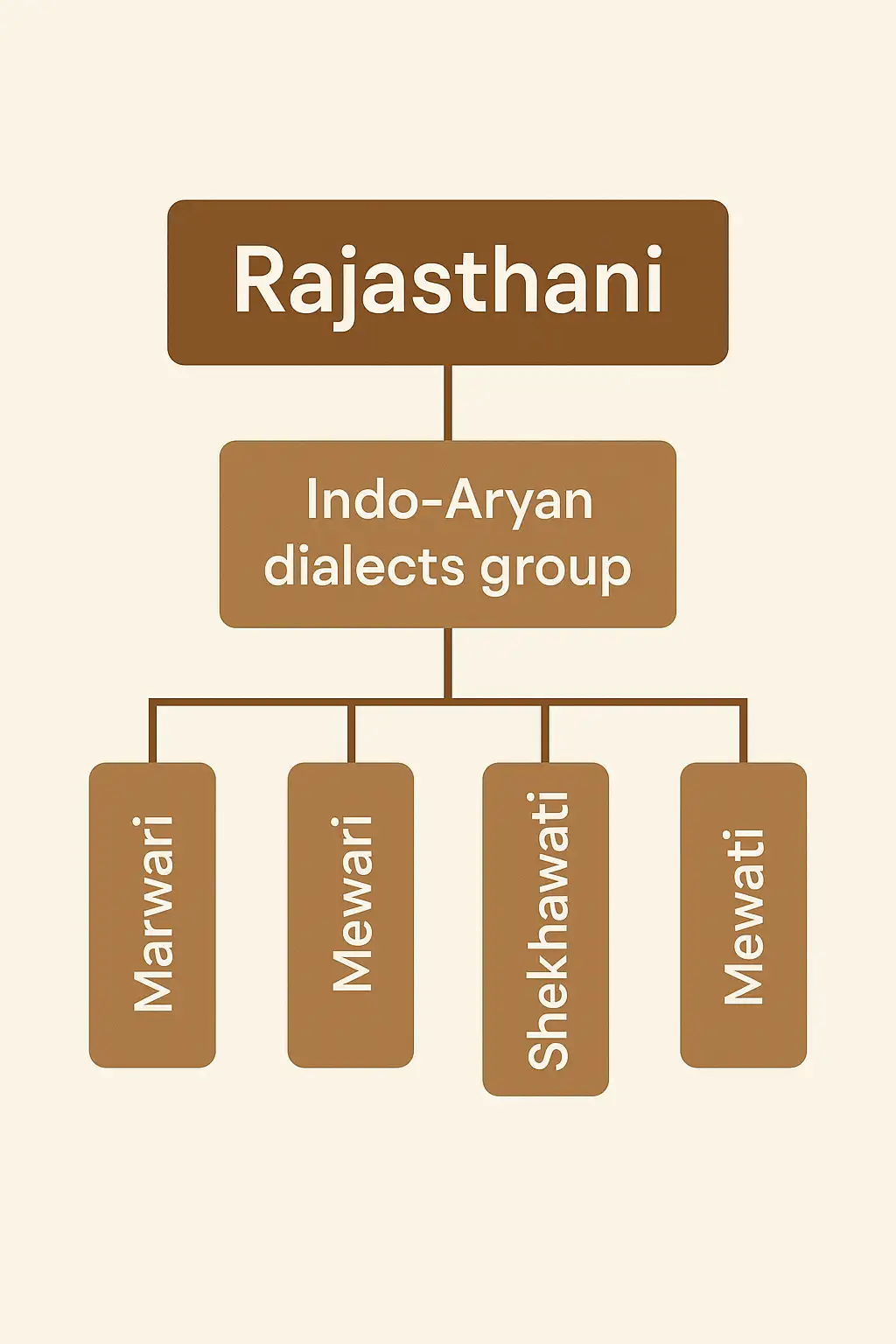
These dialects are closely related and are considered part of the Western Indo-Aryan language family. While Rajasthani is widely spoken, it does not yet have official language status in India, despite long-standing demands for recognition.
2.2 Cultural Identity of Rajasthani
Culturally, Rajasthani refers to a rich shared heritage that includes:
-
Colorful attire with heavy mirror work
-
Rich cuisine like dal-baati-churma
-
Oral traditions of ballads and storytelling
-
Grandeur of palaces and forts
Rajasthani culture is an umbrella identity that unites diverse regional subcultures.
3. Who Are the Marwaris?
3.1 Geography of Marwar
Marwar is a region located in western Rajasthan, predominantly desert and arid in landscape. The term “Marwar” comes from “Maru” (desert) and “wara” (region), meaning Land of the Desert.
Major cities in Marwar:
-
Jodhpur (cultural and administrative center)
-
Pali
-
Barmer
-
Nagaur
3.2 Marwari Language
Marwari is the most widely spoken dialect of the Rajasthani language group. It is native to the people of Marwar and serves as a primary means of communication in everyday life.
Key Features:
-
Closely related to Hindi but with distinct vocabulary and pronunciation
-
Not standardized in written form, but used richly in oral poetry and folk songs
-
Informal writing often uses Devanagari script
Marwari has also influenced trade languages in other parts of India due to migration.
3.3 Marwari Identity Beyond Language
Interestingly, the term “Marwari” has expanded beyond geography. In cities like Kolkata, Mumbai, or Chennai, “Marwari” is often used for any Rajasthani trader or businessman, regardless of whether they’re from Marwar.
However, within Rajasthan, “Marwari” refers specifically to people from the Marwar region. They are widely known for their entrepreneurial spirit and historical dominance in trade and finance sectors across India.
Know more: The Magnificent History of Marwar
4. What is Mewari?
While Marwar lies in the west, Mewar dominates the south-central part of Rajasthan. Known for its heroic history, royal heritage, and artistic excellence, Mewar has a distinct identity that sets it apart from the rest of Rajasthan.
4.1 Geography of Mewar
Mewar is a lush, hilly region marked by Aravalli ranges, lakes, and fertile plains. Unlike the dry desert of Marwar, Mewar enjoys a relatively moderate climate and green landscapes.
Major cities in Mewar:
-
Udaipur – the City of Lakes, and the heart of Mewar
-
Chittorgarh – known for its massive fort and tales of Rajput valor
-
Rajsamand
-
Bhilwara
4.2 Mewari Language
Mewari is a dialect of the Rajasthani language family, predominantly spoken in the Mewar region. Like Marwari, Mewari is primarily used in oral communication and has subtle but important differences.
Key Features:
-
Uses Devanagari script when written
-
Slightly softer and more musical in tone compared to Marwari
-
Includes regional vocabulary and grammatical structures that differ from Marwari
Here’s an example:
| Phrase | In Marwari | In Mewari | Meaning (English) |
|---|---|---|---|
| How are you? | थांरो हाल रो? (Thāro hāl ro?) | थारो हाल के? (Thāro hāl ke?) | How are you? |
| What is your name? | थारो नांय के है? | थारो नाव के है? | What is your name? |
Mewari is not only a dialect but a carrier of the Mewari identity, used in folk songs, devotional bhajans, and oral history.
4.3 Cultural Uniqueness of Mewar
Mewar’s culture is shaped by its valiant past, royal traditions, and artistic sensibilities. Some elements that define Mewari culture include:
-
Legacy of Maharana Pratap: The great Rajput warrior and symbol of independence.
-
Architectural grandeur: City Palace Udaipur, Chittorgarh Fort, Kumbhalgarh.
-
Folk arts: Miniature paintings, marble inlay work, and temple sculpture.
-
Festivals:
-
Hariyali Amavasya – celebrating greenery and monsoon
-
Gangaur – honoring marital fidelity
-
-
Cuisine: More spice-forward dishes compared to Marwar; includes Gatte ki sabzi, Laal Maas, and Besan Chakki.
Mewar has also been a center for education and reform during the princely era, making it culturally progressive while retaining strong traditional values.
5. Key Differences at a Glance
To understand the distinctions clearly, here’s a side-by-side comparison of Rajasthani, Marwari, and Mewari across various parameters:
🗂️ Comparison Table:
| Aspect | Rajasthani | Marwari | Mewari |
|---|---|---|---|
| Meaning | Umbrella term for languages, culture, and people of Rajasthan | Specific dialect and identity from the Marwar region | Specific dialect and identity from the Mewar region |
| Language Type | Group of dialects in the Indo-Aryan family | Dialect of Rajasthani | Dialect of Rajasthani |
| Spoken In | Entire Rajasthan | Jodhpur, Pali, Barmer, Nagaur (Marwar) | Udaipur, Chittorgarh, Bhilwara, Rajsamand (Mewar) |
| Script Used | Devanagari (informally) | Devanagari (informal writing); mostly oral | Devanagari (informal writing); mostly oral |
| Linguistic Status | Not officially recognized as a separate language | Not official; used widely in western Rajasthan and in diaspora | Not official; spoken primarily in Mewar |
| Cultural Scope | Represents all regional cultures of Rajasthan | Culture of desert-dwelling communities, merchants | Culture of royalty, warriors, and art |
| Common Professions | Varied across Rajasthan | Historically associated with business and trade | Historically associated with agriculture and warfare |
| Notable Cities | Jaipur, Bikaner, Ajmer, etc. (varies by dialect) | Jodhpur, Pali, Barmer | Udaipur, Chittorgarh, Rajsamand |
| Perception Outside Rajasthan | Often confused with “Marwari” | “Marwari” is used broadly to refer to all Rajasthanis (incorrectly) | Less known outside Rajasthan |
| Cultural Icons | Ghoomar, Bandhej, Dal Baati | Mehrangarh Fort, Marwari business communities | City Palace, Maharana Pratap, Miniature Paintings |
📌 Summary of Key Takeaways:
-
Rajasthani is the overarching cultural and linguistic identity of Rajasthan.
-
Marwari is both a dialect and a business-linked identity of people from the Marwar region.
-
Mewari is a distinct dialect and culture rooted in the royal legacy of Mewar.
Both Marwari and Mewari fall under the Rajasthani umbrella, but each carries its own unique flavor, geography, and legacy.
6. Common Misconceptions
Despite the rich cultural and linguistic diversity of Rajasthan, there are several widespread misconceptions surrounding the terms Rajasthani, Marwari, and Mewari. Let’s clear them up.
❌ Misconception #1: “Rajasthani is one single language.”
Reality:
Rajasthani is not a single language, but a language group consisting of various dialects like Marwari, Mewari, Shekhawati, Harauti, Dhundhari, etc. These dialects can differ significantly in pronunciation, vocabulary, and grammar.
❌ Misconception #2: “Marwari means anyone from Rajasthan.”
Reality:
Outside Rajasthan, especially in metropolitan cities like Mumbai, Delhi, or Kolkata, people often refer to any Rajasthani person as “Marwari.” However, Marwari strictly refers to people from the Marwar region, especially those who speak the Marwari dialect.
This generalization overlooks the diversity of other regions like Mewar, Shekhawati, or Hadoti.
❌ Misconception #3: “Marwari and Mewari are the same.”
Reality:
Although both are dialects under the Rajasthani language umbrella, Marwari and Mewari are distinct in their:
-
Geographic usage (Marwar vs Mewar)
-
Tone and vocabulary
-
Cultural context and heritage
Each has its own oral traditions, folk tales, and community practices.
❌ Misconception #4: “These dialects are dying or irrelevant.”
Reality:
While these dialects aren’t officially recognized or widely taught in schools, they are very much alive—spoken in homes, sung in folk music, and used in cultural storytelling. There is growing interest in preserving and promoting them through:
-
Local literature and poetry
-
Regional cinema and theater
-
Linguistic activism for Rajasthani’s inclusion in the 8th Schedule of the Indian Constitution
📌 Why These Misconceptions Matter
-
Cultural preservation: Misunderstandings lead to the erasure of unique regional identities.
-
Policy & education: Accurate awareness helps push for linguistic rights and regional representation.
-
Social respect: Using correct terms strengthens mutual respect and inclusivity among diverse communities.
7. Why These Differences Matter
In a culturally rich and diverse region like Rajasthan, understanding the differences between Rajasthani, Marwari, and Mewari is not just an academic exercise—it’s a way to honor identity, history, and heritage.
🏛️ 1. Cultural Preservation
Each dialect and region of Rajasthan carries its own stories, songs, customs, and traditions. Recognizing the distinctions between them helps:
-
Document folk tales and oral literature more accurately
-
Preserve language nuances in poetry and performing arts
-
Support local crafts and rituals that are unique to Marwar or Mewar
Example: The miniature painting style of Mewar is different from the crafts of Marwar, and knowing their origin is essential to preserve authenticity.
🗣️ 2. Linguistic Recognition
The Indian Constitution currently does not recognize Rajasthani as a separate language, despite it being spoken by over 20 million people. One of the main hurdles is the lack of awareness about its structure and sub-dialects.
By understanding dialects like Marwari and Mewari as part of a broader Rajasthani language family, there’s a stronger case for:
-
Inclusion in the 8th Schedule (official languages of India)
-
Creation of language resources, educational tools, and dictionaries
-
Academic research and regional literature development
🌍 3. Identity and Diaspora
For Rajasthani communities living across India and abroad, their regional identity—Marwari or Mewari—is a vital connection to their roots.
-
Business families from Marwar still speak Marwari at home, even in places like Kolkata or Chennai.
-
Mewari diaspora communities celebrate festivals like Gangaur and Hariyali Amavasya in their own dialect and style.
Recognizing and respecting these identities prevents cultural homogenization and ensures that future generations remain connected to their heritage.
📚 4. Academic and Tourism Relevance
Understanding the regional distinctions is also important for:
-
Tourists visiting Rajasthan who want to learn more about local history and traditions.
-
Researchers and students studying Indian languages, anthropology, or history.
-
Filmmakers and content creators looking for cultural authenticity.
Example: A documentary on Mewar’s royal legacy would be incomplete without understanding the Mewari dialect and Mewar’s warrior traditions.
🤝 5. Mutual Respect Within the State
Within Rajasthan itself, recognizing that Marwari and Mewari people have different traditions, dialects, cuisines, and attire promotes unity through diversity. It encourages mutual appreciation rather than a one-size-fits-all identity.
8. Conclusion
Rajasthan is a land where dialects shift every few miles, and traditions change from one region to the next. Understanding the difference between Rajasthani, Marwari, and Mewari opens a window into this incredible diversity.
So next time you meet someone from Rajasthan, ask—“Marwar se ho ya Mewar se?”
Because knowing the difference is knowing Rajasthan.
